From The CRPG Addict
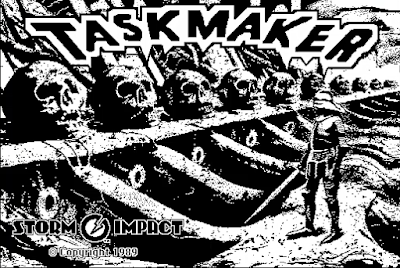 |
| This is a pretty morbid way to organize your “to do” items. |
TaskMaker
United States
Storm Impact (developer); XOR (publisher)
Released 1989 for the Macintosh
Remade and re-released as shareware in 1993
Remade and re-released as shareware in 1993
Date Started: 15 May 2020
TaskMaker is a slick little game, probably the best I’ve played so far on the Macintosh. It uses the platform’s strengths in graphic detail and sound but offers a fuller RPG experience than most Mac games of the era. While it has that inescapable “cutesy” look of most Mac games, it’s relatively long and hard, and it has enough good, new ideas to break out of the “Ultima clone” status that you might otherwise assign it at first glance.
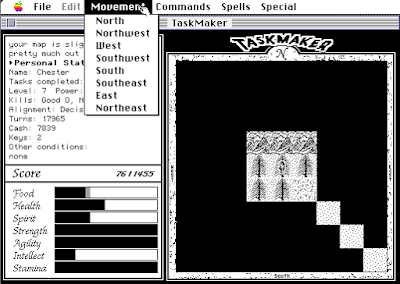 |
| It’s typical of a Mac game to offer menu options for movement. At least this isn’t the only way to move. |
We owe reader LanHawk yet another appreciation pin for tracking this down, in this case writing to the original developer for the files. Because almost everything written about the game is about the 1993 version, being able to cover the original is a nice coup. I’ll have more on the development and the two versions on a subsequent entry; I’ll probably take a run through the 1993 version while I’m covering the game rather than saving it for 1993.
The backstory is relatively short: The land was once at peace, under the direction of a wise king. When the king died, the “governing body split into three confrontational factions.” The main character is an adventurer who remembers the way things used to be. He decides to restore order by becoming Master of the Land, but lacking experience and guidance, he seeks out the TaskMaker, an advisor of the former king.
 |
| The TaskMaker introduces himself. |
Character creation is a process of selecting a name, then selecting five personal attributes from a list of 20. Your selections calibrate your maximum totals for seven attributes: food, health, spirit, strength, agility, intellect, and stamina. Current totals for these attributes are represented with a bar, and they deplete as you walk around the kingdom and fight. You find various potions and objects to restore lost attributes. Most important are those that restore health, because it depletes fastest in combat, and food, because everything else can be restored with rest.
 |
| Creating a character. I imagined this one something of a bard. |
The game world is a relatively small 100 x 100, dotted with castles, dungeons, towns, and caves. The TaskMaker lives in a castle to the center-east of the land, and the basic setup is that you go to him, he gives you a quest, you go out into the world to find and complete the quest, and you return to the TaskMaker for a reward and the next quest. Quests take place in towns or dungeons. The game doesn’t make a lot of distinction between dangerous areas and safe ones, as dangerous monsters can appear in towns or castles, including the TaskMaker’s, and NPCs can appear in dungeons.
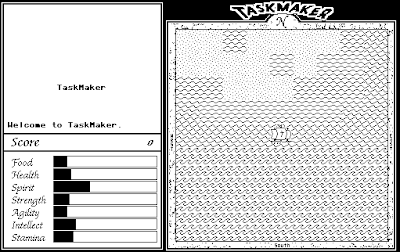 |
| The game opening has you sailing to the TaskMaker’s shores. Too bad you don’t get to keep the boat. |
The equipment system is pretty advanced, offering slots for helmets, armor, cloaks, amulets, belts, gauntlets, bracers, boots, rings on both hands, and an item in each hand–either a weapon and shield, a two-handed weapon, or dual-wielding two weapons (I found the latter to be much better). No matter how much money you make, the shops (which only show you items you can afford) always seem to have a better item available.
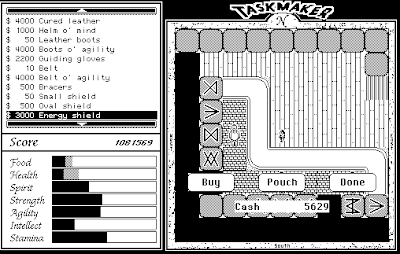 |
| Buying items in the shop. |
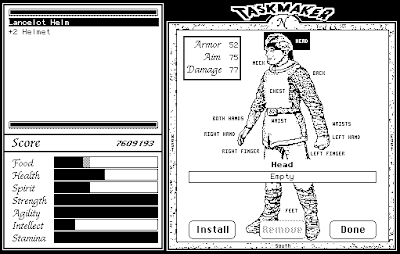 |
| Choosing between two helms. |
Monsters are a mix of traditional (goblins, orcs, kobolds) and somewhat original, although most of the original ones are also kind of silly, like happy faces and evil computers. I haven’t met any so far with much in the way of special attacks or defenses. None of them seem capable of magic or attacks at range, for instance. They’re simply differentiated by how many hit points they can whack away in a single combat round.
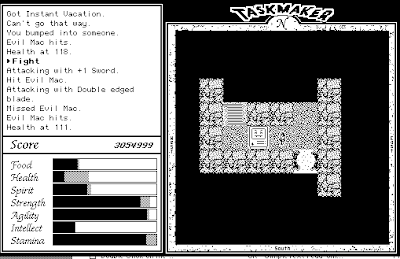 |
| The “Evil Mac” is a goofy enemy. |
Combat is of the early Ultima type, where you hit (F)ight and hit the creature in front of you, although it has a little more complexity with spells and usable items. Combats are quite tough, even well into the game. For the first few hours, I had to repeatedly use what we might call “exit-scumming,” by which I would lead an enemy to the exit of an area, fight as long as possible, retreat to the outer area, rest, and re-enter to continue fighting. This is made possible partly by your one advantage: you can carry a huge amount of equipment–more than 60 items. That’s enough food, potions, or whatever to outlast any enemy. But I occasionally found myself in impossible situations where enemies would appear both outside and inside at the same time.
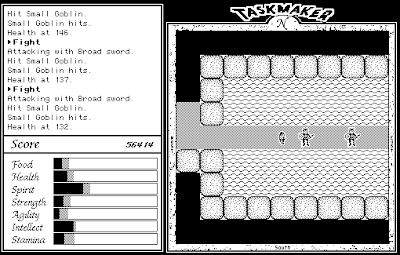 |
| Battling some goblins on a bridge. |
This is where we get into another of the oddities of the game: when you die, you don’t die permanently; you go to Hell. You can escape Hell by fighting your way through demons and solving a maze (if you die in Hell, you just reappear in Hell), but you then have to go find your non-equipped equipment back on the surface. You also lose your gold in the process.
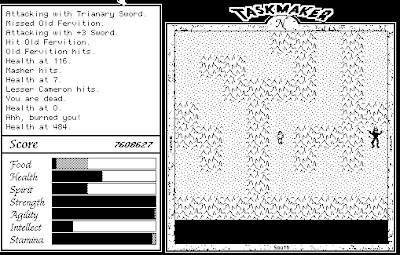 |
| Wandering through Hell’s maze. |
This system unfortunately introduces a weird way to cheat. The game tracks the world state independently from the character state. This theoretically allows you to have multiple characters active at once, although I don’t know how this works with the TaskMaker. Thus, if you die and reload instead of escaping from Hell, you’ll still find a pile of equipment where your character last “died.” You could use this to infinitely replicate useful objects like potions or expensive objects that you can sell at the store. I didn’t deliberately cheat this way, but it’s annoying and hard to get out of Hell, and there were times that I reloaded and then picked up some of my old, duplicated items if I happened to come across them. To avoid temptation, I’ve been trying to reload before I die in times when death seems inevitable.
The separation of character from world means that you can also take advantage of commands to reset a particular map or the entire game world, keeping your character as-is. It’s a good option if you want to clear the same dungeon twice, finding double the treasure and experience.
 |
| Little piles of stuff mark the location of previous deaths. |
The controls are quite good, offering keyboard backups to all of the menu commands. Spells are cast with SHIFT and the first letter of the spell. There’s an “Invoke” spell that lets you type in your own spells that you might find during the game, but it apparently also a way for the developer to introduce cheat codes and interface changes. I’ve been slow to explore spells; the one I’ve used the most is the “Strike” spell which casts a bolt at enemies. I tend to use it on fleeing enemies so I don’t have to chase them.
Sound is also quite well-done. Much of it uses spoken voice recordings. (In fact, one voice they used, a deep bass, sounds eerily like my own.) When you first start the game, the voice says, “TaskMaker.” A different one says, “What is it?” when you use the (I)dentify commands. There are screams for deaths on both sides and solid attack and spellcasting effects.
The TaskMaker’s first task was to retrieve a package he left in Skysail Village. It was in an area of the village amidst a horde of monsters and required me to figure out a switch puzzle. The game is fond of puzzles involving doorways blocked by electric forcefields for which you have to find a switch to deactivate. When I returned the package, he rewarded me with five “Instant Vacation” scrolls, invaluable items that replenish all of your meters.
His second task was to retrieve a chessboard in his own castle. It was in an area north of the bar. Getting it involved fighting a few monsters, but it was otherwise pretty easy. He gave me a double-bladed sword.
 |
| My reward for the second quest. |
For Task 3, he wanted me to travel to some silver mines, where he owns a share, and kill some conspirators who had taken over the mines, bringing him back a golden chalice as proof. This was a tough mission; the mines were full of numerous tough monsters, but also some nice treasure rewards. By the time it was done, I had mostly magic gear and a magic sword in each hand. The TaskMaker’s reward was a suit of platemail, a huge armor upgrade from the leather I was wearing before.
 |
| Battling a “war wizard” in the silver mine. |
I’m still working on Task 4, which is to find an unknown magic item in the “sands of Porta.” He indicated he doesn’t know where the item is buried, so I might be “in for a lot of digging.”
 |
| The TaskMaker gives the fourth mission. |
As you quest, you amass experience and gain levels (I’m on Level 7 now) and your attributes increase. I guess they must increase proportionally to the skills you actually use because my spirit and intellect (which governs magic) have barely gone up but my strength, agility, and stamina are almost at maximum. Health and maximum food didn’t budge for a while but increased a bit during the last few hours.
Other features of the game:
- The game tracks your karma based on how many good, neutral, and evil creatures you’ve slain and other acts like stealing from shops and houses in town.
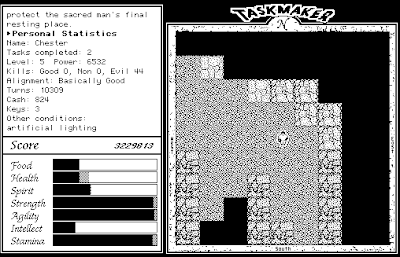 |
| Checking out my personal statistics. I’m “basically good.” |
- There’s also a score. It increases every time you solve a quest or kill a creature and slowly decreases as you move around in between those moments. High scores are tracked on a scoreboard.
- There’s an “identify” command that will tell you what’s in front of you. An “action” command will use it if it’s usable.
- A “get info” command tells you a bit about the history of whatever area you’re in.
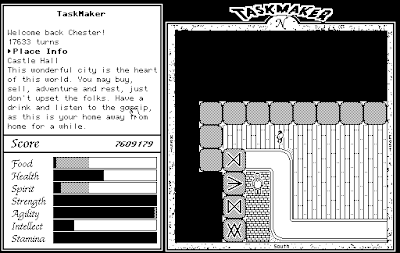 |
| The TaskMaker’s castle. |
- The game has its own “runic alphabet” used for shop and city signs. It’s not translated in the game manual, so I suppose you have to figure it out by noting the runes in places where you can guess what they’re saying. I haven’t been bothering with them, but I wonder if I’m missing hints and clues because of it.
 |
| As I’m in Skysail, I’m guessing those runes say “SKYSAIL.” |
- NPCs aren’t terribly valuable in this game unless you bribe them by giving them things. Even then, they rarely tell you anything you need to know.
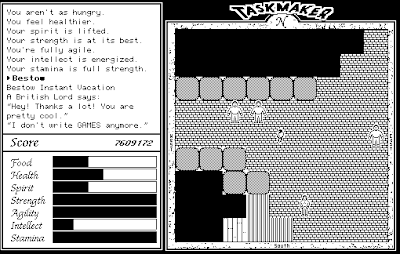 |
| The game pokes fun at Lord British. I didn’t realize his adoption of a more executive role was well known in 1989. |
-
If you drink alcohol, you start to go the wrong direction when moving. I think Ultima introduced this, but I don’t remember what edition. IV, probably.
- There’s a fun system where you can find valuable objects like gold bars and necklaces and “cash them in” at ATMs. It feels like ATMs were pretty new in 1989. I think my Maine hometown may have only gotten one that year.
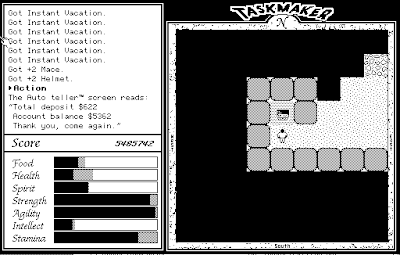 |
| Finding an ATM in a dungeon. This dungeon happens to be full of treasure, so it was a relief to find it. |
- There’s a set of miscellaneous game options I’ve never seen in any other place. I feel like every game could benefit from these. I don’t know what “wandering monsters” does, though. Un-checking it doesn’t seem to stop them from appearing.
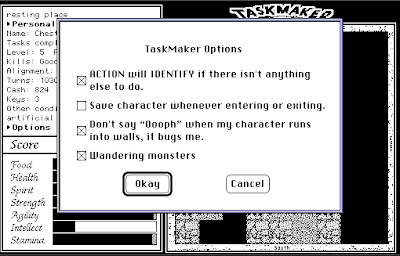 |
| Setting various game preferences. |
- A shop in the castle offers an invisibility cloak. If you put it on, the shop will no longer transact with you because you’re invisible.
 |
| Come on! You’re the one who sold it to me! |
I rather enjoy this basic approach: offer an open game world with a variety of small missions. You don’t have to follow the TaskMaker’s quests exclusively; nothing stops you from simply exploring the towns and dungeons in a random order, or even from solving some of the quests before the TaskMaker even gives them to you. We’ve seen this approach before, going all the way back to Akalabeth, but this is perhaps the first game to use it with such a variety of lengths, difficulties, and objectives.
But while I’m having fun, it’s tempered by an inability to ever feel like I’m getting more powerful no matter how much my statistics and inventory increase. Every time I think I’m doing well, some new enemy suddenly pops up in a familiar location and kicks my butt. Frankly, if it hadn’t been for the extra Instant Vacations I’ve been able to loot from locations where I’ve died, I’m not sure I would have been able to make it this far. I think eventually a cycle of starvation and poverty would have put me in a permanent downward spiral. I’ve watched videos of the remake, and it looks like the developers took the edge off the difficulty level between the two, although the remake still seems challenging.
The number of entries will be determined by the number of tasks, I guess. Ten would be just about perfect. I suspect the TaskMaker is going to turn out to be evil based on the things he’s having me do and how he reacts if I happen to pop by with a task unfinished.
Time so far: 6 hours.
Original URL: http://crpgaddict.blogspot.com/2020/05/game-367-taskmaker-1989.html
